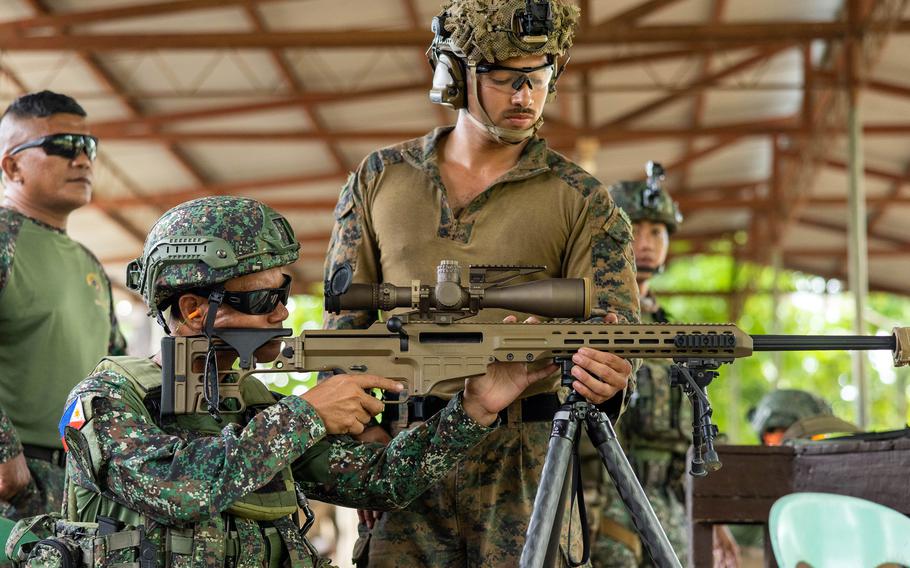
Cpl. Manuel Herrera, of Marine Rotational Force-Darwin, shows a Filipino marine a semi-automatic sniper system during training near Cotabato city in Mindanao, Philippines, April 7, 2025. (Ezekieljay Correa/U.S. Marine Corps)
Marines from California are in the Philippines training where memories of a recent war against Islamic insurgents are still fresh.
A rifle company — 150 to 200 Marines — from 2nd Battalion, 1st Marine Regiment at Camp Pendleton is on the island of Mindanao training with Philippine troops ahead of the Balikatan exercise, a Marine spokesman said.
The battalion is part of Marine Rotational Force–Darwin, a 2,500-strong, air-ground task force that recently kicked off a six-month stay in Australia’s Northern Territory.
The Marine force is “projecting its operational reach well beyond northern Australia,” according to a statement emailed Tuesday by spokesman Capt. Johnny Fischer.
The force, based in Australia’s Northern Territory, is also preparing for Balikatan, a long-running joint exercise with the Philippines scheduled for April 21 to May 4.
On March 31, the U.S. and Philippine marines launched Marine Exercise 2025 in Maguindanao del Norte, Mindanao. The 480 troops are focusing on small-unit tactics and a final “full mission profile” simulating combat conditions, the Philippine army said in an April 1 statement.
“Successfully completing this full mission profile alongside the [Philippine marine corps] will ensure combined readiness across a broad range of future potential missions,” the rotational force statement said.

Marines and sailors with Marine Rotational Force-Darwin and Filipino troops practice the fireman’s carry technique near Cotabato city in Mindanao, Philippines, April 1, 2025. (Ezekieljay Correa/U.S. Marine Corps)
Mindanao was the site of a five-month battle in 2017 between the Philippine government and Islamic militants in Marawi city. Backed by U.S. Army Special Forces, the government ultimately regained control. The conflict displaced about 120,000 people and damaged nearly all structures in the battle zone, according to the Modern War Institute.
With the insurgent threat on Mindanao reduced, the Philippine military turned to Beijing’s efforts to control disputed territory in the South China Sea.
However, U.S. forces continue to support counterinsurgency efforts on Mindanao. A Marine and three defense contractors were killed in a Feb. 6 plane crash during a support mission in Mindanao.
This year’s Balikatan is expected to be the largest iteration of the exercise yet, with about 10,000 U.S. and 6,000 Philippine, Australian and Japanese troops participating, according to U.S. and Filipino officials.
The event will be a “full battle test,” officials said, featuring a live-fire, counter-landing drill on the western Philippine island of Palawan in coordination with the U.S. Army’s 1st Multi-Domain Task Force.
“Our ability to project and integrate forces in multiple locations at once is a testament to the scalability and adaptability of the [rotational force],” force commander Col. Jason Armas said his unit’s statement.
While the main exercise is underway, Combat Logistics Battalion 1 will rehearse humanitarian and disaster relief operations with the U.S. Army and French forces in New Caledonia and Wallis and Fortuna. Marines will also work with Australian troops in Papua New Guinea to locate and mark unexploded ordnance, according to the statement.